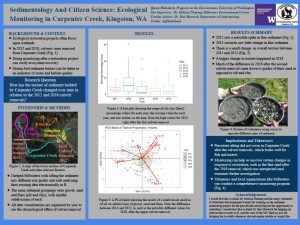Sedimentology and Citizen Science: Ecological Monitoring in Carpenter Creek, Kingston, WA
Monitoring is a key component of any successful ecological restoration project. Being able to see how an ecosystem responds to restoration treatments is not only vital for planning out future restoration work, but also for more fully understanding how an ecosystem functions. The aim of this study was to examine the relationship between two culvert removals done in Carpenter Creek, a tidal creek feeding an estuarine wetland in North Kitsap, and the texture of the alluvial sediments bedded by the creek. To accomplish this task, I used the R programming language to analyze and visualize sediment texture data collected by Stillwaters Environmental Center, an environmental monitoring non-profit operating out of the local area. Sediment samples were sifted into different size grades after collection for particle size analysis. My data visualizations suggest that the first culvert removal, done near the mouth of the creek in 2012, resulted in a change in overall texture and an increase in fine sediments, while in 2014 and 2016 sediment texture drifted back towards the base state seen in 2011. In 2018, when the second culvert, this time located upstream near the marsh, was removed, a greater change in texture and increase in finer sands was observed. These results suggest that an increased level of stream connectivity has been achieved, thereby allowing a freer and more natural sediment transportation regime. This increased understanding of Carpenter Creek’s evolution was made possible through a long-term monitoring effort by local volunteers and interns.
